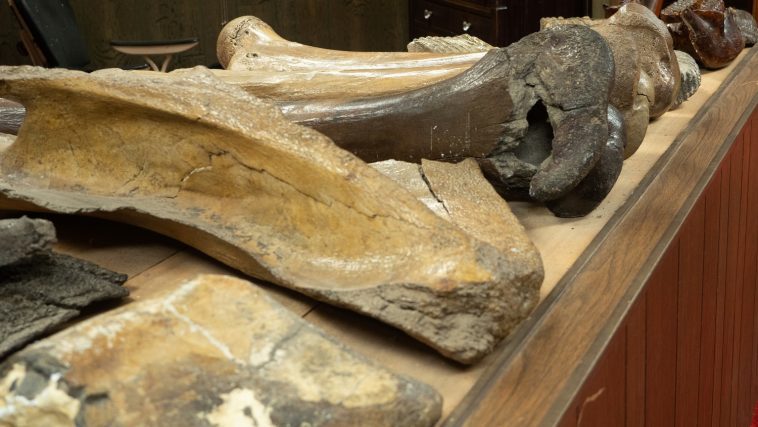[Originally published as The American Biology Teacher Uses False Statements to Reassure Teachers]
In 2020, a reader sent me this article from The American Biology Teacher. It attempts to assure biology teachers that the large amounts of carbon-14 found in dinosaur fossils are compatible with the scientifically irresponsible idea that those fossils are millions of years old.
The reader asked me to comment on the article since I have said several times that carbon-14 in dinosaur bones is a very strong indication that the bones are not millions of years old. The author of this article (Dr. Philip J. Senter), however, is confident that this is not a problem at all. How can he be so confident? Because he seems to believe a lot of false information.
Early on, he makes a statement that indicates he has not studied carbon-14 dating very seriously:
…bone mineral is usually useless for radiocarbon dating, even though the carbonate that bone mineral incorporates during life contains 14C. The uselessness of bone mineral for radiocarbon dating is due to the fact that bone mineral accumulates new 14C after death, yielding a falsely young radiocarbon “age.”
This statement is utterly false, and anyone who knows carbon-14 dating would know that. Hundreds of radiocarbon dates have been published in the scientific literature using bioapatite, a bone mineral. This study examined using bioapatite in carbon-14 dating extensively, comparing it to two other commonly-used substances in carbon-14 dating. It concluded:
Most Holocene samples exhibit reliable 14C ages on the bioapatite fraction. Late Pleistocene samples have shown reliable results even for extremely poorly preserved bone in the case of samples derived from a non-carbonate environment.
The Holocene supposedly dates back to about 11,700 years, while the Pleistocene supposedly goes back to 2.6 million years. “Late Pleistocene” samples, then, would be samples that go back to the limits of carbon-14 dating (about 50,000 years old). Indeed, in that study, one of the samples had a carbon-14 date of 37,000 years old, which is older than most of the dinosaur bones that have been dated with carbon-14.
So the idea that minerals from bone are “useless” for carbon-14 dating is demonstrably false.
Dr. Senter tries to back up his statement with a reference, but the reference doesn’t invalidate the use of bioapatite in carbon-14 dating at all. It does indicate that when you compare the date derived from collagen (a non-mineral that is often used in carbon-14 dating) to the date derived from bioapatite, the bioapatite date is often younger. However, the results depend heavily on where the fossil was found.
More importantly, we know this has nothing to do with the carbon-14 dates of dinosaur bones, since many dinosaur fossils have been dated using both mineral and non-mineral samples (including collagen), and the ages are similar. In a hadrosaur fossil, for example, bioapatite dated as 25,670 years old, while the collagen dated as 23,170 years old. Note that contrary to the study Senter cites, in this case, the bioapatite age is older than the collagen age.
Senter then tries to explain why dinosaur bones read so young with carbon-14 dating. Most of his argument boils down to the idea that modern carbon has gotten into the fossils, and since the modern carbon is very young, it makes the fossil read young.
The problem with that, of course, is that if modern carbon is getting into the fossil from the environment, there must be more contamination near the surface of the fossil and less near the center of the fossil. Thus, the carbon-14 age of the bone should vary depending on where in the bone the sample was taken. However, that’s not what is seen.
In this study, Figure 7 has circles around the dates for samples taken from different parts of the same bone. They show very good agreement, indicating that what is being detected is not from contamination.
There is one argument Dr. Senter makes which isn’t about contamination
He says that radioactive materials can be absorbed by a bone, and those radioactive materials can cause nuclear reactions which will add carbon-14 to the bone, making it look young. Once again, he cites studies to support his claim, such as this one, but once again, the studies don’t support his claim.
For example, the study I just linked shows how uranium decay can lead to the production of carbon-14, but as anyone who understands nuclear reactions would tell you, the effect is ridiculously small. Indeed, the study shows that nuclear reactions can account for no more than one hundredth (1/100) of the lowest amount of carbon-14 detected in dinosaur bones! Thus, there is no way that nuclear reactions are a viable means of explaining the carbon-14 found in dinosaur bones.
In the end, then, we see that Dr. Senter must use false information to assure his readers that carbon-14 in dinosaur bones doesn’t invalidate the dogma that they are millions of years old.
Unfortunately, since many teachers read the magazine in which his article was published, I am sure that this false information will be spread around, fooling unsuspecting students. Nevertheless, the more this is investigated, the more we will see that it poses a huge problem for those who are committed to believing that dinosaurs lived millions of years ago.







